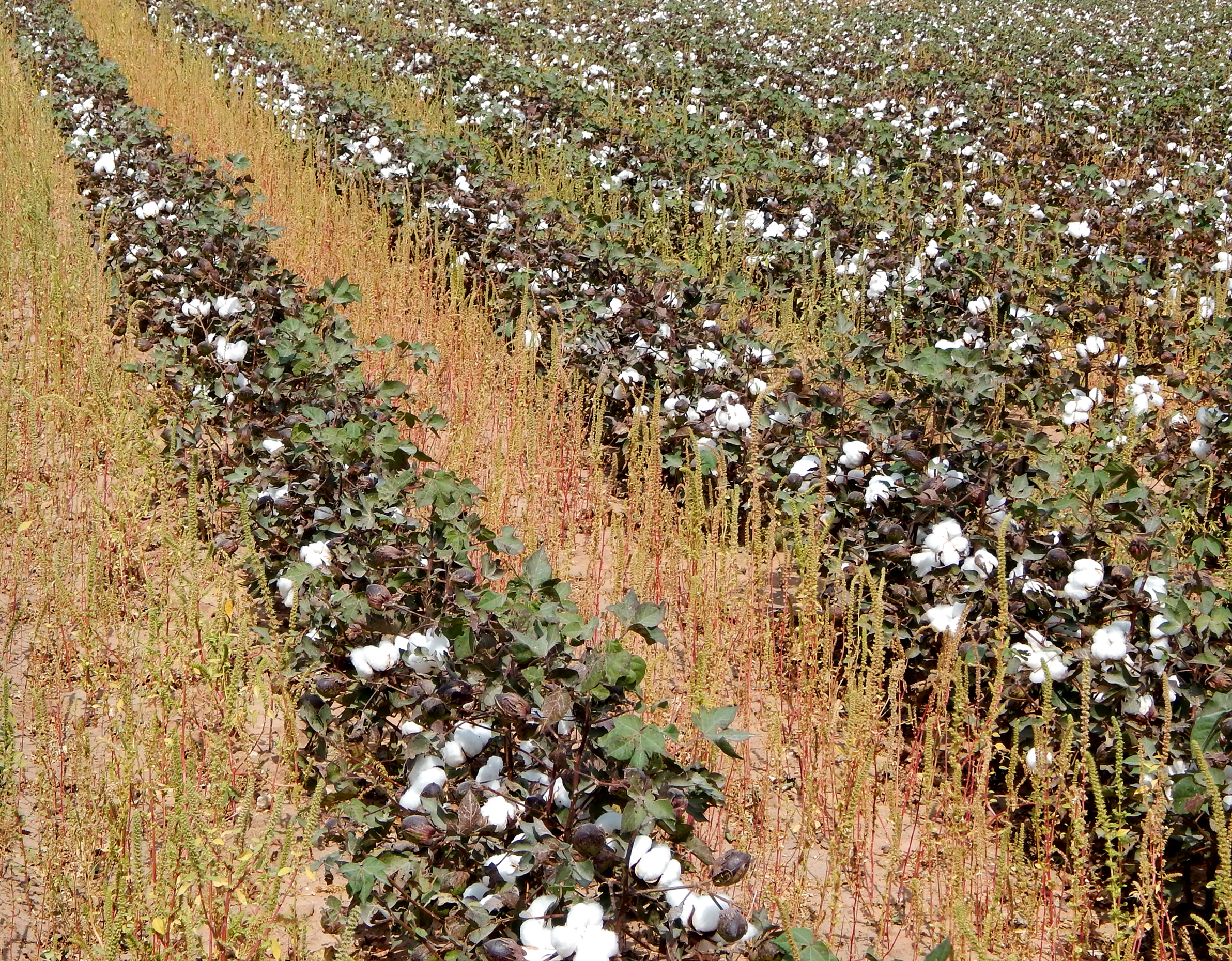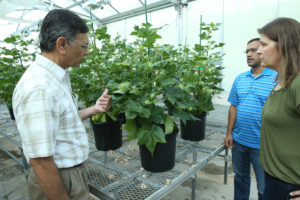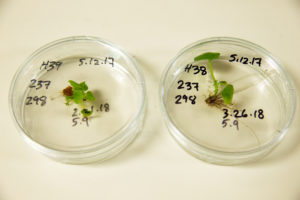Farm & Ranch
[AgriLife Today] Engineered cotton uses weed-killing herbicide as nutrient

By: Kay Ledbetter
AgriLife Research battles herbicide-resistant weeds
Writer: Kay Ledbetter, 806-677- 5608, [email protected]
Dr. Keerti Rathore, 979-862-4795, [email protected]
COLLEGE STATION – A newly developed fertilizer system will provide nutrition to engineered cotton crops worldwide and a deadly dose to weeds that are increasingly herbicide resistant, according to a Texas A&M AgriLife Research study.
Dr. Keerti Rathore examines the health of ptxD-cotton plants being grown in the greenhouse for seed increase for a field trial with Dr. Devendra Pandeya and LeAnne Campbell. (Texas A&M AgriLife photo by Beth Luedeker)
The new system applies phosphite to cotton crops engineered to express a certain gene — a gene that makes cotton able to process the phosphite into nutrition while the same compound suppresses weeds that are unable to use it, researchers said.
“Our researchers here at Texas A&M AgriLife have addressed an issue that costs producers billions of dollars,” said Dr. Patrick Stover, vice chancellor of agriculture and life sciences at Texas A&M in College Station and AgriLife Research acting director. “This is an economical, envrionmentally safe and sustainable solution.
Stover said this is an exciting and timely discovery in the movement to get ahead of the ongoing problem of weeds evolving faster than the chemicals and other methods developed to control them.
“We believe the ptxD/phosphite system we have developed is one of the most promising technologies of recent times that can help solve many of the biotechnological, agricultural and environmental problems we encounter,” said Dr. Keerti Rathore, an AgriLife Research plant biotechnologist in College Station.
“Selective fertilization with phosphite allows unhindered growth of cotton plants expressing the ptxD gene while suppressing weeds” is the title of a Proceedings of the National Academy of Sciences of the United States of America journal article to be released the week of June 4. The article will be found at: https://tinyurl.com/ptxDcottonphosphite.
Phosphorus is a major element required by all living beings – life is not possible without it. Most organisms can only utilize phosphorus in the form of orthophosphate.
“We have determined ptxD-expressing cotton plants can utilize phosphite as a sole source of phosphorus while weeds cannot, thus making it effective at suppressing weed growth,” Rathore said.
LeAnne Campbell and Dr. Keerti Rathore examine the quality of engineered transgenic cotton plants regenerated from tissue cultures. (Texas A&M AgriLife photo by Beth Luedeker)
The transgenic plants expressing the bacterial ptxD gene gain an ability to convert phosphite into orthophosphate, he said. Such plants allow for a selective fertilization scheme, based on phosphite as the sole source of phosphorous for the crop, while offering an effective alternative to suppress the growth of weeds that are unable to utilize this form of phosphorus.”
The international research team led by Rathore consists of Dr. Devendra Pandeya, Dr. Madhusudhana Janga, Dr. Muthu Bagavathiannan and LeAnne Campbell, all with Texas A&M AgriLife in College Station. Others are Dr. Damar Lopez-Arredondo and Dr. Priscila Estrella-Hernandez at StelaGenomics Inc. and Dr. Luis Herrera-Estrella at the Center for Research and Advanced Studies of the National Polytechnic Institute, all in Irapuato, Mexico.
This research was funded in part by Cotton Inc. Weed herbicide resistance and weed control are the No. 2 and No. 3 concerns of U.S. cotton farmers after input costs.
A cultured somatic embryo developing into a normal cotton plantlet following introduction of a transgene into cotton cells some 10 months previously. (Texas A&M AgriLife photo by Beth Luedeker)
“We can and will deliver for our cotton producers in Texas and beyond, in collaboration with Cotton Inc. and partners,” said Dr. Bill McCutchen, executive associate director of AgriLife Research in College Station.
Weeds typically are managed manually, mechanically or chemically. However, he said, chemical control options are rapidly shrinking due to an increasing number of herbicide-resistant weeds in crop fields, with few alternatives on the horizon.
“Over the years, it has become abundantly clear that new strategies are needed for weed control to sustain agriculture production while reducing our dependence on herbicides,” Herrera-Estrella said. “There is an urgent need for alternative weed suppression systems to sustain crop productivity, while reducing our dependence on herbicides and tillage.”
Rathore, who has been researching genetic improvement of cotton for more than 20 years, said herbicide-resistance in weeds in not just a U.S. problem, but rather a global challenge for producers of cotton, corn and soybeans.
Such a development will also relieve some of the negative perceptions associated with the use of herbicide-resistance genes and heavy dependence on herbicides, he said.
Rathore has also developed cotton plants that produce very low levels of gossypol in the seeds to improve the safety and nutrition aspects of the cotton seed, but simultaneously maintain normal levels of this chemical in the foliage, floral parts, boll rind and roots for protection against insects and pathogens.
He previously published a report identifying ptxD as a selectable marker gene to produce transgenic cotton plants. The ptxD gene derived from Pseudomonas stutzeri WM88 encodes an enzyme that changes phosphite into orthophosphate, a metabolizable form of phosphorus, when expressed in transgenic plants.
Importantly, the ptxD/phosphite system proved highly effective in inhibiting growth of glyphosate-resistant Palmer amaranth, Rathore said. Resistance to current technologies in this highly noxious weed started showing up in fields about 10-15 years ago.
“The results presented in our paper clearly demonstrate the ptxD/phosphite system can serve as a highly effective means to suppress weeds under natural, low-phosphorus soils, including those resistant to the herbicide glyphosate, while allowing better growth of the ptxD-expressing cotton plants due to lesser competition from the debilitated weeds,” Rathore said.
Unlike weeds acquiring resistance to herbicides, he said it is highly unlikely weeds will gain the ability to use phosphite as a source of phosphorus.
“In order for a weed to acquire the ability to utilize phosphite, one of its dehydrogenase genes will have to undergo a complex array of multiple mutations in its DNA sequence – that’s unlikely to happen by random mutations that occur in all organisms,” Rathore said.
Another important point, he said, is compared to phosphate, phosphite has higher solubility and a lower tendency to bind soil components. So, if it is applied in proper formulation to prevent leaching, lower quantities can be used without sacrificing the crop yields.
“Even if some phosphite ends up in streams and rivers and eventually in lakes and the sea, the algal species will be incapable of using it as a source of phosphorus, thus preventing toxic algal blooms that kill fish and other creatures in water bodies,” Herrera-Estrella said.
Future studies will focus on testing ptxD-transformants in the fields that are low in phosphorus as well as evaluating the utility of phosphite as an over-the-top ‘herbicide,’ Rathore said. Also, long-term impact of the use of phosphite as a source of phosphorus on the soil microflora under field conditions needs to be investigated.
-30-
Find more stories, photos, videos and audio at http://today.agrilife.org
Farm & Ranch
Texas FFA State Vice President Weston Parr

Future Farmers of America was founded by a group of farmers in 1928 with the mission of preparing the next generation of agriculture. It has done just that during its 95-year history, as the organization works to give back to others by following its motto, “learning to do, doing to learn, earning to live, living to serve.”
FFA is an organization made up of state associations, and at the helm of the Texas FFA is a team of 12 officers representing their respective areas within the Lone Star State. These individuals dedicate a year of their lives as they serve members, provide leadership, and work together with the state staff and board of directors to develop policy and lead the organization of over 177,000 members.
North Texas is represented by Area IV and Area IV, stretching from Wilbarger County to Bell County and from Runnels County to Grayson County. This year, those chosen to lead this great area are State President Isaac Hawkins Jr., Area IV, and State Vice President Weston Parr, Area V.
Parr is from the Sam Rayburn FFA chapter and the Area V Association, but the leader who now serves more than 19,100 members of Area V entered the FFA organization as a shy teenager who sat in the back of the room.
“I didn’t talk to a whole lot of people. I didn’t know what I wanted to do with my life or where I could see myself, so I wasn’t involved on my high school campus,” Parr recalled.
“Then I started FFA and slowly but surely, my ag teachers worked me into attending more contests, meeting new people, and speaking. I remember the first time I gave an officer speech to my chapter. I can still remember how embarrassing it was. To see the progression from that moment to speaking on stage at the state convention in front of thousands of people. Now I feel like I can enter the industry I want and be successful all because of what FFA afforded me for five years.”
There is not much Parr did not do during his time in high school. His contest participation included chapter conducting, wool judging, cotton judging, wildlife, and job interview, but his favorite was extemporaneous speaking, which he did not start until his senior year of high school.
“I wish I could go back to my freshman, sophomore, and junior years and start that sooner. I think if I had more time, I would have been more successful than I already was, but that was something I didn’t realize I liked at the time. I’m not naturally somebody who likes to speak in public, but it was actually my favorite,” Parr said.
Parr won several awards during his time competing. In 2023 alone, Parr earned the Texas FFA Service-Learning Proficiency title, was a National FFA Service-Learning Proficiency finalist, and a Texas FFA Extemporaneous Speaking finalist. In addition to his CDE and LDE events during high school, he showed commercial steers at Houston, and boilers at most major shows, participated in the county show with projects in ag mechanics, showed goats from time to time, and showed heifers until graduation.
“FFA provides invaluable resources and knowledge to be successful once you leave high school and you are out of the blue jacket for the first time. I have been a part of a lot of great organizations over the years, and they are all great in their own way, but in my opinion, FFA is the most successful at producing members of society who want to go and do something with themselves,” Parr said.
He was halfway through his time as Area V Association President and attending the national convention when he began to ponder the idea of running for state office.
“This is around the time when you usually figure out if you want to go through and be a state officer or you decide that area officer is your last run. I was unsure of where I wanted to go, but I knew I didn’t want to be done with FFA. I decided maybe it would be a good opportunity not only for me to make more friendships and connections, but also to give back to the program that allowed me to be able to do what I can do today,” Parr explained.
To read more, pick up a copy of the May issue of NTFR magazine. To subscribe by mail, call 940-872-5922.
Farm & Ranch
Texas FFA State President Isaac Hawkins, Jr.

FFA is an organization made up of state associations, and at the helm of the Texas FFA is a team of 12 officers representing their respective areas within the Lone Star State. These individuals dedicate a year of their lives as they serve members, provide leadership, and work together with the state staff and board of directors to develop policy and lead the organization of over 177,000 members.
North Texas is represented by Area IV and Area IV, stretching from Wilbarger County to Bell County and from Runnels County to Grayson County. This year, those chosen to lead this great area are State President Isaac Hawkins Jr., Area IV, and State Vice President Weston Parr, Area V.
These young leaders share a drive to give back to the organization that has given to them as they work to support FFA members while preparing for a future in the agricultural industry.
From the 12 selected representatives, delegates elect a president and first vice president, with the remaining 10 serving as vice presidents from their respective area associations. The selection process consists of a popular vote by delegates at the state convention, which accounts for 40 percent of the decision, and a committee process that includes a written knowledge exam, worth 10 percent, and an interview, accounting for 50 percent. This year, after all was said and done, Hawkins was named this year’s Texas FFA President.
Hawkins grew up as part of a large, blended family with five sisters and three brothers. While he says he did not grow up in agriculture, his youth was spent outside fishing and doing all things outdoors with his father, whom he calls his best friend. As he entered Hirschi High School in Wichita Falls, Hawkins knew he wanted to be a vet but was unsure of what courses to take to set himself on that path.
“I signed up for ag principals just because they had animals in the description. The first day of class we talked about churning butter, and I went to my school counselor that same day and told her to change my schedule immediately, but she refused. She made me stay there,” Hawkins laughed. “Luckily, I had an incredible ag teacher, and she really helped me to fall in love with the program.”
To read more, pick up a copy of the May issue of NTFR magazine. To subscribe by mail, call 940-872-5922.
Farm & Ranch
Hazards of Backyard Poultry

By Barry Whitworth, DVM
Having backyard poultry is a popular agriculture enterprise. According to the United States Department of Agriculture, 0.8 percent of all households in the United States have chickens. People keep chickens for a variety of reasons with table eggs being one of the more common reasons.
Unfortunately, some of these poultry producers are not aware of the hazards that come with keeping poultry because many times they carry pathogens but appear healthy.
Chickens are carriers of several zoonotic diseases. These are diseases that can be passed from animals to humans. According to a recent survey in Pennsylvania, a majority of backyard poultry producers were aware of the dangers of avian influenza. However, this study also revealed that far fewer producers were aware of the risk of possible exposure to Salmonella and Campylobacter.
The lack of knowledge about the hazards of raising poultry likely contributes to the continued issues of Salmonella outbreaks associated with backyard poultry. In 2023, the Centers for Disease Control and Prevention reported 1,072 illnesses of Salmonella linked to backyard poultry, and 272 of those patients required hospitalization. Oklahoma reported 43 individuals with the disease.
To read more, pick up a copy of the April issue of NTFR magazine. To subscribe by mail, call 940-872-5922.
-

 Country Lifestyles1 year ago
Country Lifestyles1 year agoScott & Stacey Schumacher: A Growth Mindset
-

 Equine7 months ago
Equine7 months agoThe Will to Win
-

 Country Lifestyles7 years ago
Country Lifestyles7 years agoStyle Your Profile – What your style cowboy hat says about you and new trends in 2017
-

 Country Lifestyles4 years ago
Country Lifestyles4 years agoAmber Crawford, Breakaway Roper
-

 HOME7 years ago
HOME7 years agoGrazing North Texas – Wilman Lovegrass
-

 Country Lifestyles7 years ago
Country Lifestyles7 years agoDecember 2016 Profile, Rusty Riddle – The Riddle Way
-

 Country Lifestyles8 years ago
Country Lifestyles8 years agoJune 2016 Profile – The man behind the mic: Bob Tallman
-

 Outdoor9 years ago
Outdoor9 years agoButtercup or Primrose?









